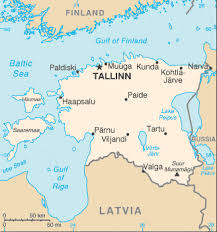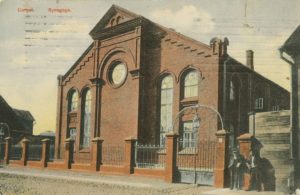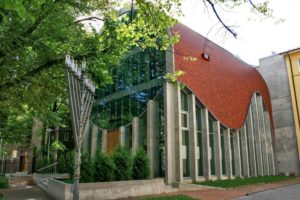 Jews were in Estonia as early as the 14th century. But the permanent Jewish settlement of Estonia did not begin until the 19th century, when they were granted the right to enter the region by a statute of Russian Tsar Alexander II in 1865. Jews with higher education, or who were skilled artisans or successful merchants, were allowed to settle. Synagogues existed in Tallinn in 1883 and Tartu in 1901, but these were destroyed during Soviet bombing raids in March 1944.
Jews were in Estonia as early as the 14th century. But the permanent Jewish settlement of Estonia did not begin until the 19th century, when they were granted the right to enter the region by a statute of Russian Tsar Alexander II in 1865. Jews with higher education, or who were skilled artisans or successful merchants, were allowed to settle. Synagogues existed in Tallinn in 1883 and Tartu in 1901, but these were destroyed during Soviet bombing raids in March 1944.
Between the end of World War I and 1940, Estonia was an independent republic. In 1939, the Jewish population of Estonia numbered about 4,500, a tiny percentage of the country’s population. Almost half the Estonian Jews lived in Tallinn, the capital city. The rest lived in other towns, such as Tartu, Valga, Parnu, Narva, Viljandi, Rakvere, Voru, and Nomme.
 Before Germany invaded Estonia in 1941, the majority of the Jewish community was evacuated to the Soviet Union. However, approximately 10 percent of the Jews had already been deported to Siberia in June 14 in 1941.
Before Germany invaded Estonia in 1941, the majority of the Jewish community was evacuated to the Soviet Union. However, approximately 10 percent of the Jews had already been deported to Siberia in June 14 in 1941.
The Nazis prepared to murder all Estonian Jews. German SS and police units, together with Estonian auxiliaries, massacred the Jews of Estonia by the end of 1941. No ghettos were created in Estonia during the German occupation.
Starting in 1942, tens of thousands of Jews from other European countries were sent to forced-labour camps inside Estonia. The main camp was Vaivara. These labourers built military defenses for the German army and mined shale oil. Thousands of foreign Jews were also murdered at Kalevi Liiva. With the advance of the Soviet army in the fall of 1944, the Nazis evacuated the Estonian camps, as well as other camps throughout the Baltics. Some Jews were transferred by sea to the Stutthof concentration camp near Danzig. Many thousands were forced on death marches along the Baltic coast.

Although Jews who had fled Estonia to relative safety within the Soviet Union returned after the war, virtually no Estonian Jews still in the country at the time of the German occupation had survived. The four Estonians held most responsible for the murders at Kalevi-Liiva were accused at war crimes trials in 1961. Two were later executed; the others avoided sentencing by going into exile. About 1,500 Jews from Tallinn returned after the war.
In Estonia there is now only a small Jewish community of just under 2,000 people, compared to about 4,500 who lived in the country before the Holocaust. At the end of the Soviet occupation, in 1988, a Jewish Cultural Society was established in Tallinn. The Tallinn Jewish School was re-opened in 1990, being the first school for a national minority to be established in the independent Republic of Estonia. Currently, the Jewish Community in Estonia consists of about 2,000 people. In 2007 a new synagogue – “Beit Bella” in Tallinn, which was the first synagogue to open since the Second World War.